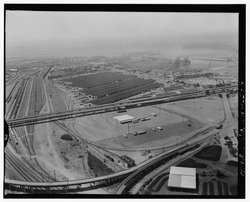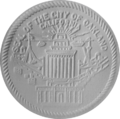Oakland Army Base
| Oakland Army Base | |
|---|---|
| Oakland, California in United States of America | |
 | |
| Coordinates | 37°49′00″N 122°18′02″W / 37.81667°N 122.30056°WCoordinates: 37°49′00″N 122°18′02″W / 37.81667°N 122.30056°W |
| Type | Army Base |
| Site information | |
| Open to the public | No |
| Site history | |
| Built | 1941 |
| In use | 1941-99 |
The Oakland Army Base, also known as the Oakland Army Terminal, was a former United States Army base in the San Francisco Bay Area of California. The base was located on the Oakland waterfront just south of the eastern entrance to the San Francisco–Oakland Bay Bridge.[1]
Construction of the base commenced in 1941, as an expansion of the San Francisco Port of Embarkation based at Fort Mason on the San Francisco waterfront. Initially named the Oakland Sub-Port of the San Francisco Port of Embarkation, the base was renamed the Oakland Army Base in 1944. The installation moved in excess of 8.5 million tons of cargo during World War II, and 7.2 million tons of cargo passed through the terminal during the Korean War.[1]
In 1946, the Oakland Army Base expanded to incorporate the administrative and cantonment area of the Port formerly known as Camp John T. Knight in honor of World War I Brigadier General John Thornton Knight.[2]
In 1955 the San Francisco Port of Embarkation became the U.S. Army Transportation Terminal Command Pacific, and the Oakland Army Base became the Oakland Army Terminal. In 1964 the headquarters of the command moved from Fort Mason to the Oakland Army Terminal, and in 1966 the terminal was renamed back to the Oakland Army Base. During the Vietnam War, Oakland Army Base served as a major transit station for U.S. soldiers en route to and returning from all deployment locations in East Asia—such as Vietnam and Korea. The base closed on September 30, 1999.[1]
In 2007, the Regional Oral History Office of The Bancroft Library at the University of California, Berkeley, in partnership with the City of Oakland and the Port of Oakland, commenced a comprehensive oral history project documenting the history of the Base from when it was commissioned in 1941 to when it was closed in 1999, and thereafter.
Redevelopment
The city of Oakland has proposed a US$1billion redevelopment plan for the base.[3] Caltrans has set aside US$240million in funding for the proposal, which would transform the site into a warehousing and logistics center for the Port of Oakland.[4]
In 2008, the City of Oakland issued a Request for Qualifications (RFQ) to find a developer to undertake the redevelopment of the site. Thirteen developers submitted proposals and four were selected as finalists. Largely due to the downturn of the US economy, two of the four development interests dropped out of the process, leaving Federal Realty and AMB/CCG JV competing. In 2010 the Oakland City council selected AMB/CCG to enter into an exclusive negotiating agreement. In June 2012 the council accepted the terms of a Lease Disposition and Development Agreement with California Capital and Investment Group (CCIG)[5] and Prologis.[6] (CCG principals had incorporated, and AMB property corporation had merged with Prologis.) Under this arrangement CCIG will perform all of the master planning, public infrastructure work, rail and wharf improvements while Prologis will deliver state of the art warehouse and logistics facilities. The first phase of the project, slated to break ground in mid-2013, is estimated to cost a total of $484 million, of which $247 million is for public infrastructure.
References
- 1 2 3 "Oakland Army Base". The California State Military Museum. Retrieved 2007-12-18.
- ↑ "Camp John T. Knight". The California State Military Museum. Retrieved 2009-06-19.
- ↑ "Oakland Army Base Project". City of Oakland. Retrieved 8 November 2012.
- ↑ Oakland Army Base Development Clears Hurdle, San Jose Mercury-News
- ↑ CCIG
- ↑ Prologis
| Wikimedia Commons has media related to Category:Oakland Army Base. |
